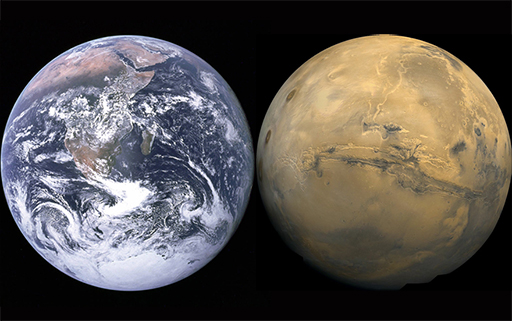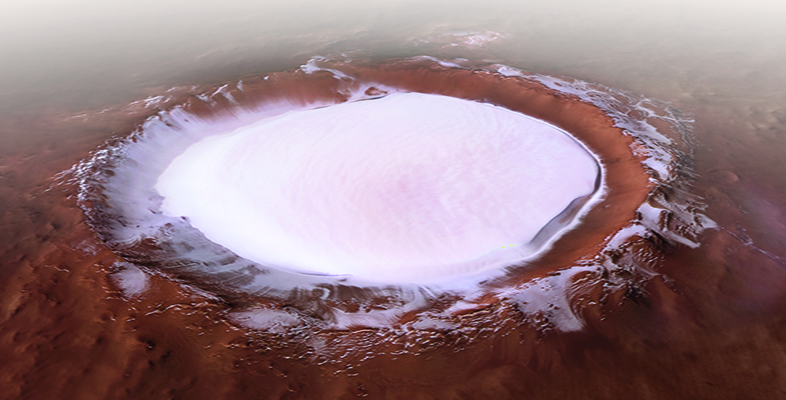The search for water on Mars
Introduction
In 1972, the crew of the Apollo 17 spacecraft took an iconic photograph of the Earth as they travelled towards the Moon. The photograph (Figure 1a), known as ‘The Blue Marble’, shows the extent of the Earth’s water held within oceans, polar ice and clouds. You may be familiar with Earth being known as the ‘blue planet’. Indeed, the Earth’s surface is approximately 70% water, with most of this within the oceans. On continents, water is found in rivers, streams, lakes and underground.

Water is also the majority component of all living organisms. The human body itself is approximately 60% water, present within blood, muscle, fat and bone. As a solvent, water can dissolve substances (such as salt and sugars) in order for them to be transported around both an organism’s body and within the natural environment. This important role means water is considered to be the principle requirement for life, not only on Earth, but also on other planetary bodies both within and outside our Solar System. For this reason, the discovery of water is the primary goal of many space missions.
Despite being 55 million kilometres from Earth, Mars (Figure 1b) can often be spotted with the naked eye in the night sky as a reddish-orange object (Figure 2). It has been observed throughout human history, with the earliest record dating back to ancient Egypt, and for this reason it has captured human imagination for millennia.
Activity 1: Mars in the night sky
If you want to find Mars in the night sky, an ideal viewing position would be a location away from artificial light sources and relatively flat. Remember that Mars’ location in the night sky is dependent on where you are on Earth, the time of year and the time of night. All planets are near the ecliptic, which is the imaginary line marking the Sun’s path across the sky, so keep an eye on where the Sun rises and sets and its path during the day and try to project this onto the night sky.
The Moon can also be used to help you. It never strays more than 5° to either side of the ecliptic during the course of each month. Remember that the ecliptic will change throughout the year and that the night sky looks different in the Northern and Southern hemispheres.
Planets usually look bigger than stars, and don’t appear to twinkle like stars might. Mars usually has a characteristic red-orange colour and can be found anywhere close to the ecliptic depending on the time of the year.
Astronomy catalogues are also available (for example NASA’s Night Sky Planner [Tip: hold Ctrl and click a link to open it in a new tab. (Hide tip)] or In-The-Sky.org) to find out when and where Mars (or any other astronomical object) is visible.
As humanity pushes its boundaries to beyond our own planet, Mars has become a primary target for exploration. In this course, you will learn more about some of these exploration efforts, specifically those that have hunted for water on Mars. You will learn about how evidence for water in Mars’ past and present has been identified, and what this might mean for Mars’ history and the possibilities of finding life there.
After studying this course, you should be able to:
- understand the history of Mars and the role of its environment on the presence of water over time
- describe the methods used to find water on Mars, including the techniques employed by robotic and orbiting spacecraft
- evaluate the evidence for water on Mars
- describe the different settings in which water has been in Mars’ past and today
- understand the implications of finding water on the possibility of finding life.

